The Most Accessible U.S. Cities: Which are the most accessible for travelers of all abilities?
When planning the perfect luxury getaway, travelers want more than breathtaking views and world-class dining. They want an unforgettable experience that everyone can enjoy. Accessibility is essential to ensuring that every member of your travel party can relax, explore, and indulge effortlessly.
At Wander, we understand that true luxury means inclusive travel experiences. To help you find the best destinations, we've analyzed America's top cities based on crucial accessibility factors like the number of wheelchair-accessible attractions, walkability, reliable public transport, and internet connectivity.
The most accessible cities in the U.S.
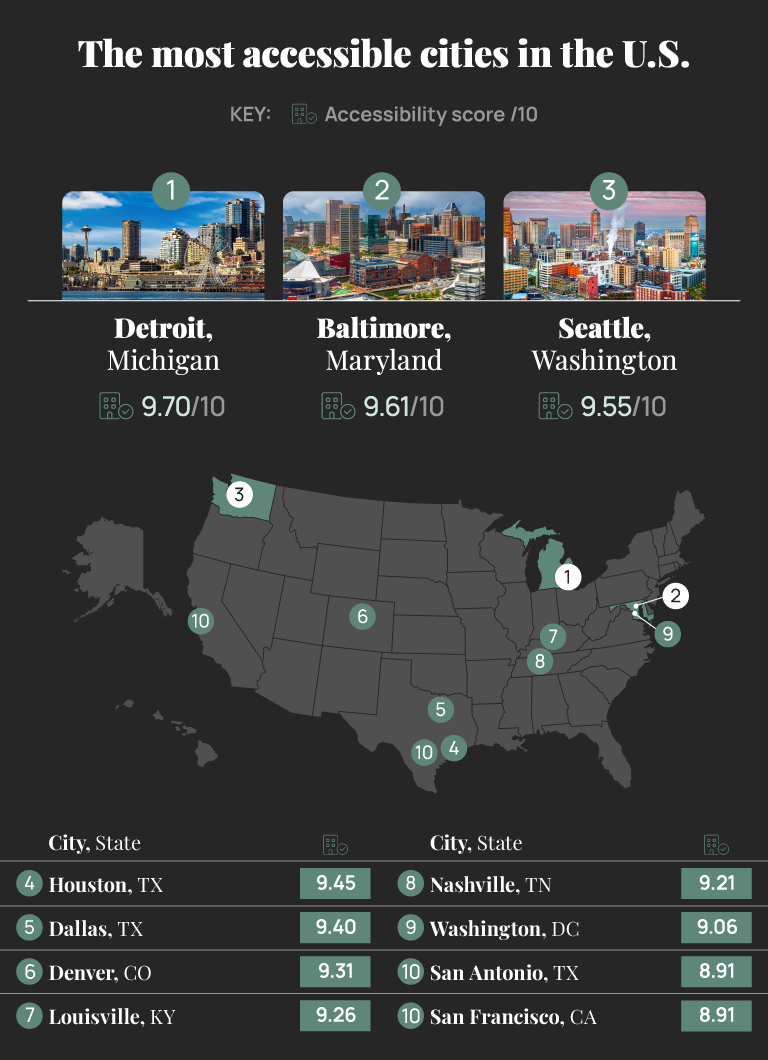
1. Detroit, Michigan - 9.70 out of 10
Detroit stands out as the most accessible U.S. city based on a combination of key factors, despite its relatively small size. Detroit earned a perfect record on ADA compliance for public rail stations, with 0% of stations being inaccessible, indicating full access for individuals with mobility challenges. Additionally, the city has 5.53 public transport stations per 100,000 people, providing decent transit options to its residents.
While Detroit’s share of wheelchair-accessible attractions is lower than in some cities (16.67%), this is balanced by a much stronger performance in its outdoor trails. With almost two-thirds (61.54%) of Detroit’s trails being wheelchair-accessible, the city is one of the best options nationwide for inclusive outdoor activities.
2. Baltimore, Maryland - 9.61 out of 10
Baltimore ranks second overall for accessibility among the most populous U.S. cities. The city stands out for its many accessible attractions and strong infrastructure for people with disabilities.
Over 41% of Baltimore’s attractions are wheelchair accessible, which shows they’re really trying to ensure everyone can enjoy the city’s cultural and historic spots.
Baltimore ranks fairly high in walkability, scoring 64 out of 100, making it easier for individuals using mobility aids to navigate the city safely on foot. Those visiting the area can expect fast wifi speeds, with a median download speed of 137.06 Mbps, ensuring reliable access to digital services, such as navigation and ride-hailing.
3. Seattle, Washington - 9.55 out of 10
Seattle ranks third in overall accessibility and scored well for its balance of wifi speeds, public transportation, and various accessible public spaces. Seattle offers a robust 37.24% of accessible attractions, 54 out of 145.
Over a quarter of its walking trails are wheelchair accessible (31 out of 119), making Seattle one of the more outdoor-accessible spots. The focus on green space and nature access makes the city a great option for residents and tourists alike.
Seattle scores 74 out of 100 for walkability, the third highest among the top ten cities. It also offers 16.02 public transport stations per 100,000 people, one of the highest densities in the country, with all of its rail stations being ADA-compliant. This means individuals with disabilities can confidently rely on public transit for daily travel.
Wander Cle Elum is a ground-level property near Seattle where visitors can enjoy the picture-perfect forest views from the floor-to-ceiling windows — perfect for people looking for an accessible escape.
The city with the most wheelchair accessible attractions
Louisville, Kentucky - 71.43% of wheelchair accessible attractions
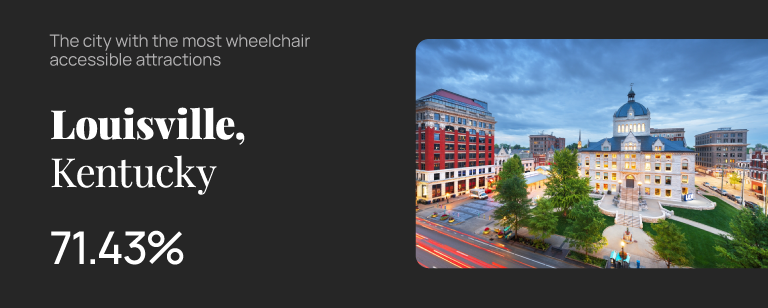
Louisville has the most things to do for wheelchair users, with 71.43% of total attractions. Some of these attractions include an Old Louisville walking ghost tour, a history and walking tour, and a ghosts, cocktails, and bites tour.
The city with the most wheelchair-friendly trails
Houston, Texas - 62.66% of wheelchair-friendly trails
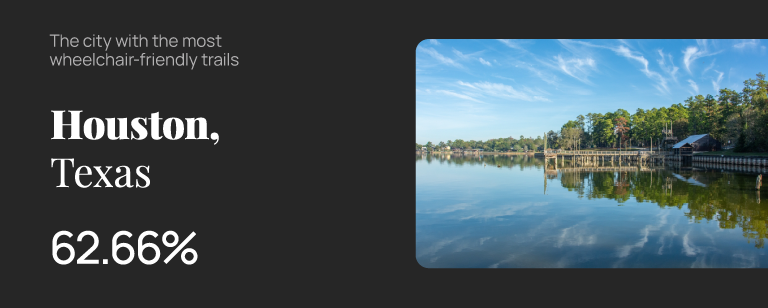
Houston is the best U.S. city for groups looking for accessible outdoor activities, with 99 wheelchair-friendly trails out of 158. The most popular trail is the Houston Arboretum and Nature Center Outer Loop Trail, a 3.7 km family-friendly trail considered easy to finish in around 40 minutes.
Another option is the Seymour Lieberman Exercise Trail, a 4.8 km gravel trail around a golf course accessible for visitors using wheelchairs, mobility equipment, or strollers.
The city with the lowest elevation range
Detroit, Michigan - 38.07 meters
Detroit is credited with having the lowest elevation range among the 30 most populated cities in the United States. This means that the difference between the city's highest and lowest points is minimal, only around 38.07 meters (125 feet).
This relatively flat terrain is mainly due to Detroit's location within the Great Lakes Basin, close to Lake St. Clair and the Detroit River, contributing to the city's consistent low height. From an accessibility standpoint, this natural flatness is a significant positive.
Unlike cities built on hilly or mountainous terrain (like Los Angeles or Seattle), Detroit's landscape poses fewer physical barriers for residents and visitors with mobility challenges. This includes not only wheelchair users, but also older adults, people with temporary injuries, those using walkers or canes, and parents with strollers. Flatter terrain can make sidewalks, public transport, and even activities more inclusive and easier to navigate.
The cities with the highest walkability scores
Washington, DC and Nashville, Tennessee - 98/100 walkability score
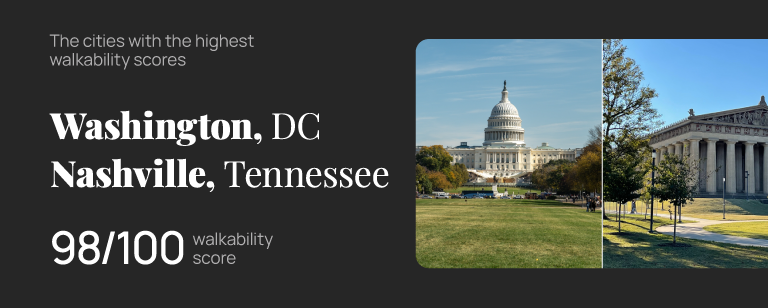
Washington and Nashville hold walkability scores of 98 out of 100. These locations are a “walker’s paradise,” which means the cities have a high degree of walkability. This implies they are designed to be pedestrian-friendly and easily navigated on foot. Specifically, in the context of the Walkability Score, a walker’s paradise is a neighborhood with a score of 90-100. This signifies that daily errands and activities can be accomplished without needing a car.
The city with the best mobile download speeds
Indianapolis, Indiana - Median download speed: 216.22 Mbps
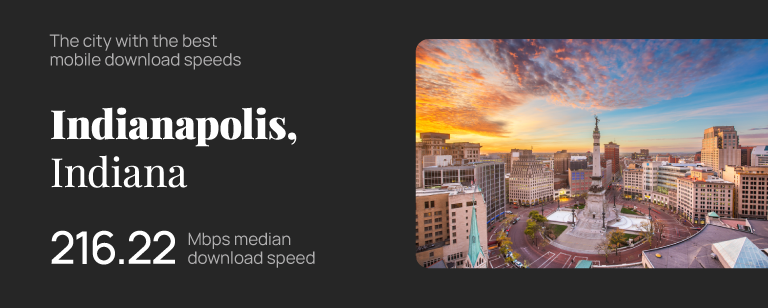
Indianapolis has the fastest median mobile download speed among the 30 most populous cities in the U.S. at 216.22 Mbps. This range is more than adequate for most online activities, like streaming, gaming, and web browsing for multiple devices. They can also make tasks much easier while traveling, such as navigating maps, finding local lunch spots, and visiting nearby attractions.
Speeds above 100 Mbps are considered fast and can handle even more demanding tasks like multi-player gaming and large file downloads. All Wander homes are equipped with high-speed Wi-Fi of 100+ Mbps, ensuring a reliable connection and dedicated work space for everyone. Whether using assistive technology, accessing telehealth services, working remotely, or staying socially connected, this level of speed supports a seamless and inclusive experience.
The city with the most public transport stations
Boston, Massachusetts - 41.45 stations per 100,000 people
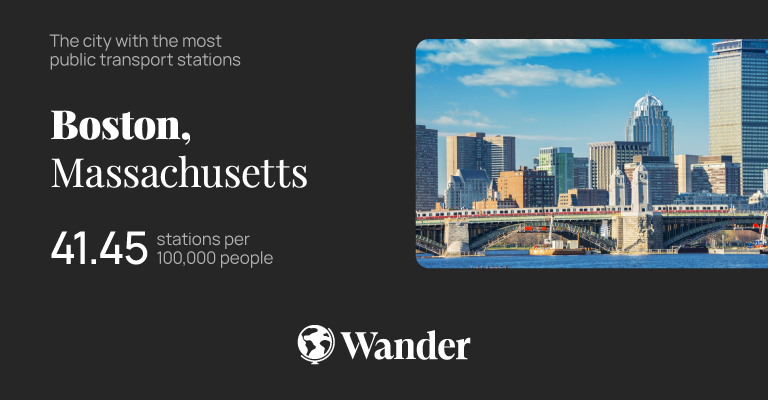
Boston has more public transport stations than any other city, with 41.45 per 100,000 people. The Massachusetts Bay Transportation Authority, commonly known as "the T," serves as the largest public transit provider in Massachusetts. It offers a variety of options, including 162 bus routes, commuter rail services, ferry connections, and paratransit options.
The subway system, North America’s oldest, sees approximately 273,000 daily riders on heavy rail and 90,700 on light rail. Opting for public transport in Boston is a much more affordable option than driving, especially when considering gas and maintenance costs.
The importance of accessibility in the vacation rental market
Matt Kowalewski, Chief of Staff at Wander.com, explains why inclusivity and accessibility are central to creating world-class vacation rentals.
“True luxury is inclusive. At Wander, we believe that accessibility should never be an afterthought; it's part of creating exceptional travel experiences. By designing homes with elements like elevators and ground-level accommodations, we ensure that every traveler, regardless of mobility, can enjoy the comfort, beauty, and adventure of a Wander escape.
“This commitment is reflected in Wander’s growing portfolio of accessible properties, which includes:
“Wander Anchor Cove (Gualala, California) features an elevator, wide doorways, and step-free access throughout the main level.
“Wander Joshua Tree (Yucca Valley, California) is designed with accessible outdoor and indoor living spaces, including a ground-level bedroom suite.
“Wander Hudson Valley (Kingston, New York) has an elevator and accessible entrance, seamlessly blending luxury with thoughtful design.
“Wander Palomar Mountain (Pauma Valley, California) offers barrier-free entry and excellent work setups, which are ideal for guests with mobility needs.”
Methodology
We built our seed list based on Wikipedia's most populated cities in the United States.
The number of attractions and wheelchair-friendly attractions in each city was collected to calculate the percentage of wheelchair-accessible attractions using Get Your Guide.
We used AllTrails to collect the percentage of wheelchair-friendly trails in each city.
Story Maps was used to find the elevation range of each city (in meters).
Each city’s Walkability Score out of 100 was taken from Walk Score.
Each city's median mobile download speeds (Mbps) were taken from the SpeedTest Global Index.
The Bureau of Transportation Statistics was used to find the percentage of transit stations that were not ADA accessible in each city as of 2023.
The number of public transport stations was taken from the Federal Transit Administration as of 2023.
This data is accurate as of 01/05/2025.
We used the PERCENTRANK formula in Google Sheets to calculate a normalized score out of 10 for each city.
Sources
https://www.getyourguide.com/louisville-l32533/wheelchair-accessible-tc239/
https://www.alltrails.com/en-gb/us/texas/houston/ada
https://www.walkscore.com/score/washington_d.c.-dc
https://gocity.com/en/boston/things-to-do/getting-around-boston
https://www.mass.gov/orgs/massachusetts-bay-transportation-authority

Download the app
By signing up, you agree to our Privacy Policy and Terms of Service.